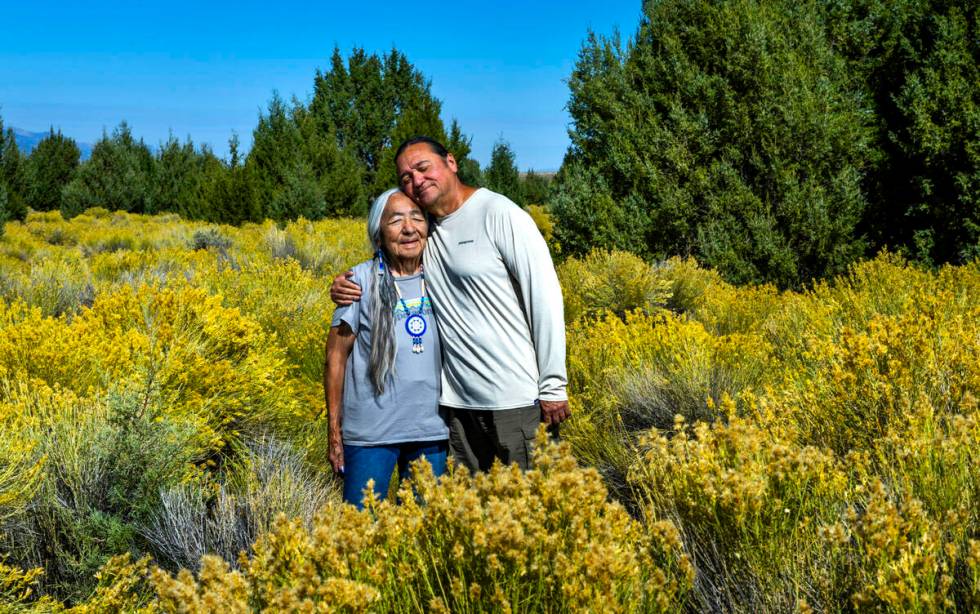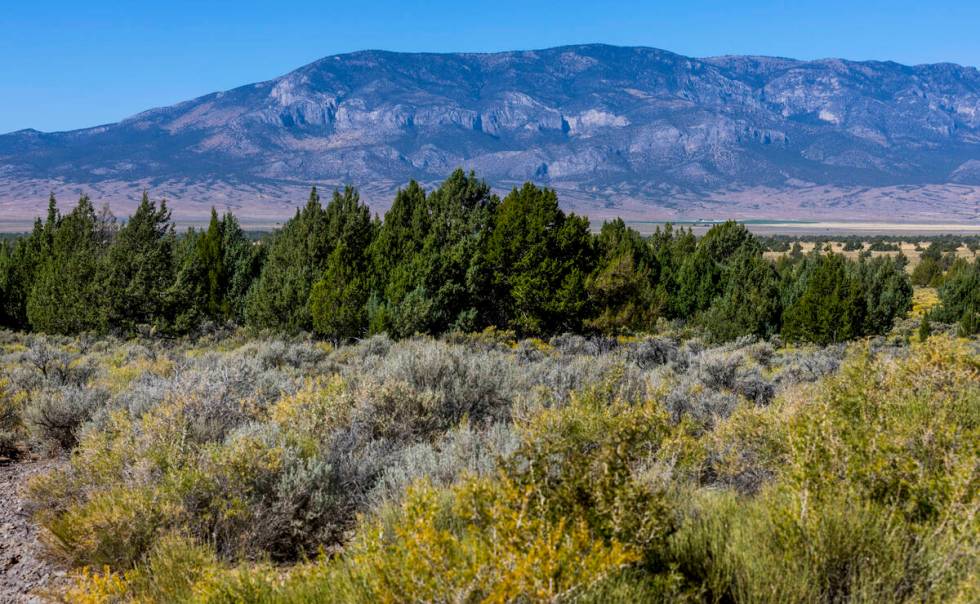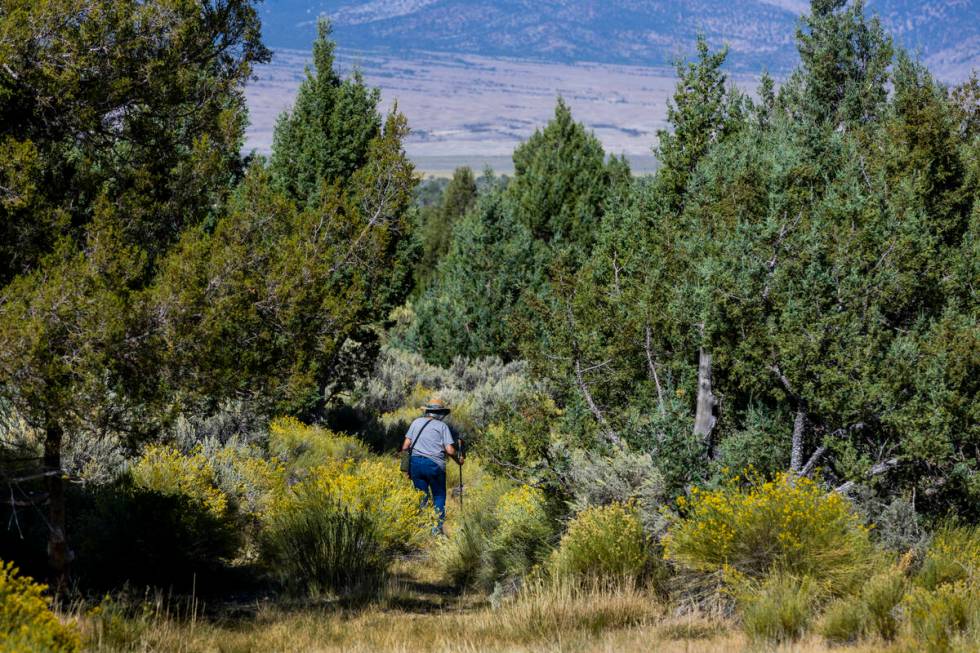ELY — Among the hills past the towering bundle of 30- to 40-foot juniper trees and sweet scent of sagebrush, 8-year-old Laurene Mamie Swallow wandered off with her friend.
This sacred spot is called Bahsahwahbee, a place of religious and cultural gathering for the Western Shoshone — a group of tribes that roamed Nevada’s Great Basin long before the state’s first colonial settlement was established in 1850. The name of the tribal site, meaning “sacred water valley” in the Shoshone language, is a nod to the groundwater that has nourished the ecosystem for centuries.
The community’s illusion of peace was shattered that day in 1897 as a group of vigilantes followed tribal members to their harvest festival and slaughtered everyone in sight — all except Swallow and her friend, who later found refuge 30 miles south with a white family. It was one of three large-scale massacres at a site tribal elders have compared in its significance to the Vatican, Auschwitz and Arlington National Cemetery.
“Everyone who was present there was murdered. Everyone except two little girls who happened to be off in the mountain hills playing when this happened,” said Delaine Spilsbury, Swallow’s 87-year-old granddaughter who has fought to protect the land and water for decades. “And one of those little girls was my grandmother.”

The 25,000-acre massacre site could become Nevada’s fifth national monument. But under the Bureau of Land Management’s plan to rapidly develop public lands into solar farms, part of that valley could one day be covered in solar panels.
That is, if federal officials permit a solar project before the site could be declared a protected national monument.
“It’s a disappointment that the BLM decided it was more important to give away land to some corporation than to show some respect for our fallen elders,” said Rick Spilsbury, a 54-year-old Ely Shoshone tribal elder and Delaine’s son. “But I think we can work this out.”
Solar situated on a sacred site
Today, the Spilsburys’ ancestors live on through the juniper trees. They haven’t always been immortalized in words.
Though tribes across the country use oral histories as preservation, the 1897 massacre and the two before it remain little known among members who still struggle to put the pain into words.
“The sad truth is that the ethnic cleansing here succeeded,” Rick Spilsbury said. “There just weren’t that many Natives to remember it.”
Delaine Spilsbury, also a tribal elder, told her son about the massacres when he was old enough.
“Most everybody that I’ve talked to in Ely, even the older people, they don’t have the knowledge of it,” she said. “It was so painful that they just didn’t share it.”
The trees — and the groundwater they rely on — might not survive a colossal effort from the Biden-Harris administration to develop hundreds of thousands of acres of solar farms in the West if the BLM’s plan gets final approval, according to the tribes.
Known unofficially as “swamp cedars” for how wet and muddy the topsoil can get during monsoon season, the trees have faced numerous threats throughout the years. Among them are the wind turbines that line the proposed monument area, a now-null Southern Nevada Water Authority pipeline proposal to harvest water and send it to Las Vegas, updated transmission lines, and coal-fired power plants that never came to be.
Now added to that list is the BLM’s Western Solar Plan, which could open nearly 12 million acres of Nevada’s public lands to accelerated solar development, the most of any of the 11 states involved in the plan. Seven-thousand acres fall within the proposed monument, about a third of the 25,000-acre site, and are within the traditional cultural property listed on the National Register of Historic Places.

“I’d like to think that they didn’t do it on purpose,” Rick Spilsbury said of the BLM.
Only about two-thirds of the massacre site was listed among the 35 million acres in Nevada that the agency determined were not suitable for solar development. In a written statement, the BLM’s national headquarters stressed its extensive tribal outreach process, where 16 Nevada tribes were contacted for input. A spokesperson declined to make the federal agency’s tribal liaison available for an interview.
‘We’re trying to protect a cemetery’
Tribal leaders involved in the monument fight — from the Ely Shoshone, the Confederated Tribes of the Goshute Reservation and the Duckwater Shoshone — have taken meetings with Biden-Harris officials in Washington, D.C., and given tours of the site to U.S. Sens. Catherine Cortez Masto and Jacky Rosen, both D-Nev.
National monument status would protect the area from being considered for solar projects, even if the final version of the plan is approved as is, the BLM said in a statement.
So far, efforts to establish the monument haven’t been enough.
Alvin Marques, chairman of the Ely Shoshone Tribe, said opposition to the monument has centered around closing off land that could be used for other purposes, such as grazing — something tribal leaders are willing to continue to allow.
“We’re not trying to violate anybody’s rights,” Marques said. “We’re not trying to close anything off. We’re trying to protect a cemetery.”

The Antiquities Act of 1906 allows the president wide latitude to designate national monuments. The law has long been controversial among Republicans, most recently seen in calls to repeal it in Project 2025, a conservative think tank’s road map for the future of the country that many have associated with a second Trump presidency.
Joe Biden used the Antiquities Act last year to recognize Avi Kwa Ame, a 500,000-acre national monument an hour south of Las Vegas. The other route is Congress; Cortez Masto introduced a bill in July to move the Bahsahwahbee monument forward.
In an interview, Cortez Masto said she remains concerned about the competing priorities of the agency, which manages about 63 percent of Nevada’s land.
Nevada is due for an update to its statewide resource management plan, a document known as an “RMP” that would set clearer guidelines for the use of the state’s natural and cultural resources, she said. Currently, the state has 12 such plans governing different areas.
“I’ve been waiting for the BLM to provide that RMP to me, still am requesting it and will not give up until I do,” Cortez Masto told the Las Vegas Review-Journal, adding that she’s in the process of writing a letter to the BLM outlining multiple concerns. “If the BLM is putting out different plans on how the land is going to be managed, they all should be coordinated.”
Rural sacrifice
The federal solar plan places much of the country’s push for rapid energy development on rural Nevada.
As of October, there are nearly 40 active applications for renewable energy projects, including utility-scale solar and wind turbines, according to a spokesman for White Pine County’s natural resources advisory board.

White Pine County is no stranger to outside developers. The Southern Nevada Water Authority, which maintains water rights in the area through working ranches, once proposed a 300-mile pipeline to extract much of White Pine’s water supply to sustain Las Vegas’ ever-growing footprint.
The water authority doesn’t have plans to renew its bid for the region’s unused groundwater, a spokesman confirmed in a statement, adding that the authority supports a monument designation that would allow local ranching to continue.
Tom Baker, a third-generation rancher who operates Baker Ranches in Snake Valley, is one of many county residents who fought against the pipeline, which they see as a failed water grab.
While solar farms don’t use much water once they are constructed, getting one up and running can take up to 1,000 acre-feet depending on size, environmentalists say. An acre-foot of water, or nearly 326,000 gallons, can sustain two single-family households for a year.
Some rural counties across Nevada, many without a dedicated natural resources manager, say they worry about how mass solar could harm the untouched desert that so many enjoy and live off of. Baker doesn’t see much rhyme or reason in how land was allocated in the BLM’s plan.
“If they are necessary, there needs to be a lot of thought on where they’re placed and how they’re built,” Baker said. “They shouldn’t just pick an area and change the whole landscape, especially if they’re not going to create a tax base to help support the counties.”
White Pine joined the Ely Shoshone Tribe and other rural governments throughout Nevada to protest the plan, saying the BLM has “completely missed the mark in terms of guiding solar development into the most appropriate places.” The agency now has the power to issue a record of decision, finalizing what it feels is the best path forward for a sacred patch of land that once belonged to the Western Shoshone.

Fight for water, land persists
On top of the Spilsburys’ roof in McGill, due north of Bahsahwahbee, is a line of solar panels. In a region of Nevada with no electric vehicle charging stations, the panels will allow them to power their new EV.
The family is willing to do its part in transitioning the country to greener sources of energy to combat climate change, something the Biden-Harris administration has shown it sees as a crisis requiring swift action.
But Bahsahwahbee is a non-negotiable, Rick Spilsbury said. And certainly not a sacrifice zone.
“Our ancestors lived there for thousands of years sustainably, and the people that came in and tried to wipe them out three times saw that as dumb,” Rick Spilsbury said. “And now, we’re starting to realize, no, it wasn’t dumb. It was wisdom.”
Though some see time running out for a national monument, getting a site recognized can take decades. After a century of three Native American massacres going untold, there’s a clearer path for the tribes’ story to gain attention.
One day, Rick Spilsbury said he sees a parking lot, paved path and maybe even a restaurant, drawing people from across Nevada and the country who want to learn about what happened. It’s something he wants his mother to see in her lifetime.
“Here’s an opportunity to tell the story of our people. And there aren’t a whole lot of us left,” he said.
“I believe in justice for all,” he added. “That’s the real American dream, or at least it should be. I think, in time, people will do the right thing. Maybe we’ll learn from all this.”
Contact Alan Halaly at ahalaly@reviewjournal.com. Follow @AlanHalaly on X.












